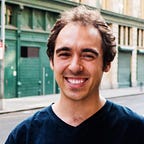Virtual Theatre in High Fidelity
How we got started studying the potential of live events in VR
Currently, Kiira Benzing, David Gochfeld, and I are working together exploring the capabilities of live performance in VR. In everything from avatars to audience, what works in VR and what doesn’t? What are the bones of an ideal production, and how well can it scale to a large audience?
In this blog we’ll be sharing some of the stories of our studies.
To start us off, let’s answer a simple question: How did this all start?
In early June of 2017, I was in Portland Oregon for the annual TCG (Theatre Communications Group) conference. My company, Agile Lens: Immersive Design, had teamed up with Fisher Dachs Associates: Theatre Planning & Design to showcase some of the ways virtual reality could be used in the design of both theatres and the shows inside of theatres.
In our demo room, we gave attendees a tutorial on how to use Tilt Brush, a VR drawing application, then let them design a set that could then be placed into an in-progress theatre design, at which point they could jump to different seats and see how the view changed. It was a hit, and we were asked to come up with something to top it for the next year. The immediate thought: What if we could do a live performance in VR?
Assembling the Team
Fast forward to August — at the VR for Change festival in NYC, I met Kiira Benzing, an up and coming director whose 360 VR short “Cardboard City” won the Samsung Gear Indie contest in 2016 and went on to become an interactive documentary featuring a VR and AR installation at the NYFF at Lincoln Center. This connection was filed away for later.
The next month I was a speaker at Jump Into VR Fest alongside David Gochfeld, a name I had heard over a year before at an Unreal Engine meetup group where I heard about plans to create a live, virtual reality Hamlet experience. David directed that production, and it became “To Be With Hamlet,” premiering at the Tribeca Film Festival in April 2017.
A few months passed with some light inter-office brainstorming, but nothing concrete emerged. In February 2018, David and my office reconnected and we started to narrow the potential directions for a show.
One month later, I gave a workshop at the VR Voice Healthcare symposium in Boston, and had the great fortune of meeting Philip Rosedale, who was keynoting, for the second time in my life. The first was in April 2015 when he saw me speak at an NYVR Meetup event about using VR for theatre sightlines. I had no idea who he was at the time, but he mentioned I should check out his new VR platform, High Fidelity, as a way to achieve realistic spatial audio in theatre designs.
Now, here in Boston and knowing full well who he and his company were and having something of an agenda, I was thrilled to find myself over the next hour discussing the many ways High Fidelity might be an ideal partner for pushing the envelope in live VR performance, in everything from full body tracking and avatar design to scaling audiences and customizing interactive environments to fit the needs of a show.
The Way Forward
Before long, David and I were having regular discussions with the High Fidelity team about scoping and budgeting a production for TCG 2018. How much equipment would we need on site? Would we use an existing environment or create a new one? Is there an existing playscript that could best showcase the affordances of VR, or should we build a new one?
I took a pass at a script based on an earlier AR-opera concept of mine. The result was a ten-minute play about sisters living in separate realities, rejoined for a short time by a portal. One exciting element we honed in on: getting the actors to perform with each other from different locations.
As the timeline got tighter we brought on Kiira Benzing (remember her?) as Director. I sat down with some members of Third Rail (Then She Fell) to talk casting and storytelling logistics. We all continued to research and perform light tests of different approaches to mixed results. After progressing deeper down the rabbit hole, and after a lot more back and forth with High Fidelity, it became clear that instead of answers, our questions were begetting more questions.
Lest we risk producing something half-baked, we ultimately decided that an ideal place to begin this venture would be a series of case studies exploring the effectiveness of different techniques and content within High Fidelity. With our combined knowledge of theatre, immersive content creation, and the past successes and failures in the industry, we discovered there was an opportunity to do some unprecedented research dives, and with the support of High Fidelity and their open-source mentality, even share findings for the benefit of other companies, organizations, and individuals interested in our discoveries.
It’s clear that we’re still in the earliest days of what this new immersive medium will become, and we’re ecstatic to be on the front lines of figuring it out.
We hope you enjoy following our journey.
